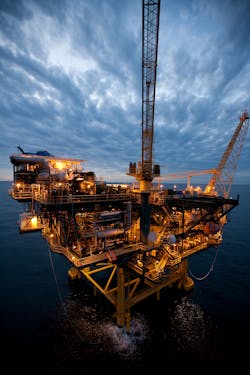Gulf operators continue to advance platform life extension projects
Many production platforms in the Gulf of Mexico are approaching the end of their service life. At the same time, new standalone developments are difficult to sanction in the current market. As a result, many operators are considering tiebacks to existing platforms, an approach that provides a lower risk and cost and faster return on investment.
The challenge with this approach is that many of the candidate platforms are 15 to 20 years old, and are thus nearing the stated end of their original design life.
It is in this context that platform life extension projects are taking on a new importance. And in the wake of the oil price collapse and COVID-19 pandemic, these projects are taking on an added momentum.
Typically, platform life extension projects will focus on extending the service life of components that are not technically or financially feasible to be replaced. Such a project will most often entail an integrity inspection of the platform’s hull, moorings, tendons, and riser systems.
The Bureau of Safety and Environmental Enforcement (BSEE) has identified critical component systems which may be most sensitive, in order to evaluate continued service beyond the original intended design service life. These systems include but are not limited to:
- Platform hull and topsides
- Compliant tower structure
- TLP tendons
- Mooring system
- Pipeline risers
- Wellbore production risers
- High pressure drilling risers.
Currently, there are 14 structures that are reportedly in various stages and phases of planning for life extension: 12 floating structures and two compliant towers. In no particular order, they are:
- Baldpate compliant tower (Hess)
- Front Runner spar (Murphy)
- Medusa spar (Murphy)
- Matterhorn (W&T Offshore)
- Neptune spar (Fieldwood)
- Hoover DDCV (Exxon)
- Magnolia (W&T Offshore)
- Allegheny (Eni)
- Conger (Hess)
- Prince TLP (EnVen)
- Devils Tower (Eni/Williams)
- Brutus (EnVen)
- Ram Powell (Talos Energy)
- Marlin (Occidental Petroleum).
Of these 14 structures, the five that are being actively developed at present are Neptune, Allegheny, Prince, Conger, and Marlin. And in addition to these 14, within the next five years there will be 10 floating structures approaching the end of their permitted design service life.
Prince and Neptune
One platform that has been targeted for life extension is the Prince TLP, currently owned and operated by EnVen Energy Corp. Located in Ewing Bank block 1003, the platform was installed in August 2001 in 1,490 ft (454 m) of water, and designed for a 20-year lifespan. But the field that currently flows into Prince continues to have strong performance, and shows signs of producing beyond 2021. Additionally, there are potential future discoveries in the area which may yield the desire for a tieback into the TLP.
For these reasons, EnVen asked ABSG Consulting to identify US regulatory requirements and conduct life extension studies that assessed the feasibility of extending the TLP’s service life for an additional 15 years.
The Prince TLP life extension project began with a plan of a series of potential engineering assessments for the hull structures, mooring systems, major hull/topsides interfaces, and riser systems. In addition, a baseline inspection plan was developed to guide the baseline inspection activities for the purpose of the TLP life extension. At the end of the life extension effort, EnVen will seek BSEE approval for life extension of the hull, the mooring systems, and risers.
Life extension works are also underway on the Neptune spar, originally installed in 1996. Currently owned and operated by Fieldwood Energy, the unit continues to produce at Viosca Knoll block 826 in 1,930 ft (588 m) of water. As the platform began to close in on its original design life, discussions about extending its service life became more frequent. Following a request by Noble Energy (the spar’s previous owner), ABS Group initiated a life extension assessment project.
The Neptune spar life extension project began with a roadmap for life extension assessments that included conducting baseline inspections; reviewing historic inspection and repairs records; undergoing gap analyses that compared the spar's current condition with the original design premise and calculations; and performing additional engineering analyses. Based on the life extension assessments, ABS has granted a class certificate for the life extension of this platform.
Regulatory approval process
One of the key challenges for life extension projects is obtaining regulatory approvals. In many ways, the regulatory compliance process is still under development. These first few life extension projects in the Gulf of Mexico are expected to provide a significant contribution to the development of guidance and criteria. BSEE officials report that the number of proposed life extension projects is steadily growing, a trend that is no doubt abetted by current market conditions. Many of these permit requests have reportedly focused on integrity verification of standard catenary risers, top tension risers, and flexibles. But the agency deemed many of these applications incomplete, and lacking the needed data that could demonstrate the feasibility of extending riser life on those projects.
In response, BSEE has introduced a plan that outlined its requirements for riser life extension permits. That plan most notably included a requirement for independent verification through a certified verification agent (CVA). The new plan also retained the previous requirements for a combination of analyses and inspections, and a forward-looking integrity management plan.
BSEE also said that a life extension CVA will need to incorporate verification in three stages. These stages, as reported by 2H Offshore, are detailed below.
Stage 1–Initial life analysis:
- Riser detailed design data, e.g. components, materials, cathodic protection, coatings/barriers, tensioners
- Historical operational data, e.g. pressure, temp, fluid chemistry, inhibitor usage
- Historical environmental data, e.g. monitored/assumed motions, currents, sea states
- Detailed analysis.
Stage 2–Inspection:
- Internal/external corrosion
- Hang off assembly – flex joint or taper joint
- Strakes/fairings condition
- Coating conditions
- Armor wire corrosion
- Tensioner condition
- Topside jumper
- Existing integrity management plan and inspection and maintenance data
- Any data to show condition of riser and components
- Example inspections; these should include visual, annulus vent tests, cathodic protection probes, coatings/barriers, pressure tests, in-line inspection (UT/MFL), optical 3D HD, and laser photogrammetry.
Stage 3–Remnant life analysis:
- Proposed riser detailed data
- Proposed operational data
- Proposed environmental data
- Detailed analysis including stage 1 and stage 2 results to prove remaining life capacity
- A forward-looking IM plan.
When the new plan was introduced earlier this year, BSEE officials urged the industry not to underestimate the time needed and required for life extension approvals. The agency recommended that operators be proactive and set up five- and 10-year life extension plans well in advance of the end of the current permit. They have also stated that the approval cycle, from submittal of a life extension request with sufficient supporting CVA documentation, is likely to be 12 weeks.
About the Author
Bruce Beaubouef
Managing Editor
Bruce Beaubouef is Managing Editor for Offshore magazine. In that capacity, he plans and oversees content for the magazine; writes features on technologies and trends for the magazine; writes news updates for the website; creates and moderates topical webinars; and creates videos that focus on offshore oil and gas and renewable energies. Beaubouef has been in the oil and gas trade media for 25 years, starting out as Editor of Hart’s Pipeline Digest in 1998. From there, he went on to serve as Associate Editor for Pipe Line and Gas Industry for Gulf Publishing for four years before rejoining Hart Publications as Editor of PipeLine and Gas Technology in 2003. He joined Offshore magazine as Managing Editor in 2010, at that time owned by PennWell Corp. Beaubouef earned his Ph.D. at the University of Houston in 1997, and his dissertation was published in book form by Texas A&M University Press in September 2007 as The Strategic Petroleum Reserve: U.S. Energy Security and Oil Politics, 1975-2005.

